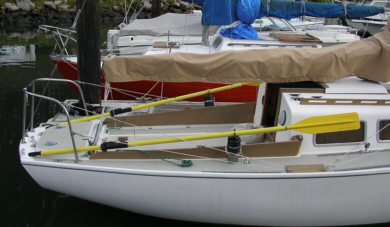


"Augustine" Photo Page
"Augustine" Structural Retrofit Page
"Augustine" Sheet-to-Tiller Self-Steering Page
"Augustine" Home Page
"This Sailing Page"
e-mail to: myrmade@solopublications.com
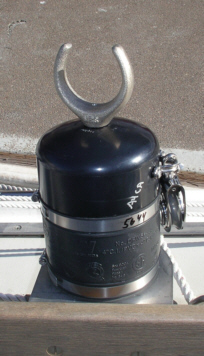
The Pearson Ariel "Augustine" was equipped with a set of rowing oars in November 2005.This page documents the approach taken to design and install mounts and oar locks for those oars. Also featured is a stern mount for a single oar to use in sculling.
The oars used in this application are Carlisle 11 foot sweeps. The oar shafts come in two pieces.The paddles are separate.
The photo to the left shows a NRS Oar lock on one of the two the mounting devices, which are slipped over the jibsheet winch.
Although hose clamps are an integral part of these mounting devices, and although the lower hose clamp can be tightened or loosened to adjust the fit on the winch base, the hose clamps do not need to be adjusted to install or remove the mounting devices.
These mounting devices also play a critical role in the self-steering gear used to provide sheet-to-tiller self-steering on headings ranging from a beam reach to a broad reach. The block shown attached to the device is part of the self steering gear. The block is not used in rowing functions.
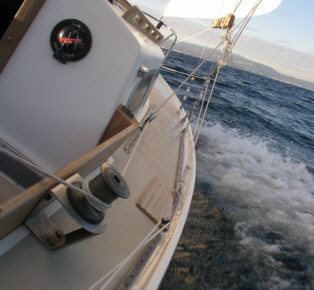
The criteria that I used to design the system were as follows:
1. The oars must be long enough and powerful enough to effectively row a 25 foot seven inch sailboat weighing over 5000 lbs.
2. The oars must break down so that they can be efficiently stored below deck.
3. The oar locks and all related hardware must be removable.
4. The rowing station must permit efficient rowing both while standing facing forward and while seated on the bridge deck facing aft.
5. The oarlock mount must be capable of holding a turning block needed for the jibsheet-to-tiller steering system.
6. Operation of the oars must not damage or weaken the coaming boards or their support structure.
The oars are two part eleven foot oars manufactured by Carlisle and sold by NRS. The oars are Carlisle heavy duty two (2) piece shafts with removable Carlisle Outfitter blades.

About these oars, NRS says, "Carlisle's tough, maintenance-free, quality tempered aluminum shafts are sheathed in colorful, abrasion-resistant polyethylene tubing. Molded plastic handles are made more comfortable with foam rubber grips. Removable blades make for easy storage and transport. seven foot (7') and seven and a half foot (7-1/2') Carlisle Oars are heavy-duty rafting models, with a one and seven-eighths inch (1-7/8") diameter aluminum shaft constructed from thick-walled tubing." Eight foot (8') and longer oars have a reinforced inner shaft for maximum strength.
Take apart oars were selected to facilitate storage below deck.
About the paddles, NRS says, "Rugged and light, Carlisle Outfitter blades are constructed of tough, UV-resistant plastic with a full-length tempered aluminum spine for superior strength, and a strong insert to withstand aggressive boating. A push-button mechanism locks the blade securely to either a Carlisle or Cataract shaft. This Outfitter blade is 6-1/2" wide."
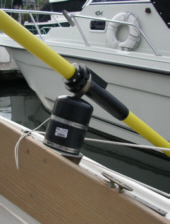
NRS Superston Open Oarlocks were selected. The NRS catalog says that "NRS Superston Open Oarlocks are the finest white water open oarlock available! Made of Superston™, a proprietary manganese, and the strongest bronze alloy of its kind. Superston's composition assures unmatchable strength and remarkable corrosion resistance under severe conditions. The 5/8" diameter, 3-1/2" long shaft is precision-turned and drilled for a split ring. The horn opening is 1-5/8" with a 2-3/8" inside diameter. Oarlocks include Split Ring keepers. These oar locks are sold individually or in pairs."
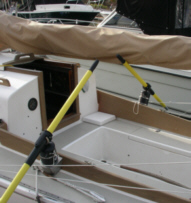
The oar lock mounting devices are home made. I designed them from reasonably-priced components available at my local sprinkler supply store. These parts are probably also available from most plumbing supply stores. The device is made from four inch ABS pipe and fittings, and some 1/8 inch thick neoprene purchased in the Industrial Department of Orchard Supply Hardware.
A removable block is attached to the oar lock mounting device in some of the photos on this page. The block is a Garhauer series 25 block that functions as part of a jib-to-tiller self- steering gear, so this device has two functions. Under test conditions at sea it has performed as designed for both of those functions.
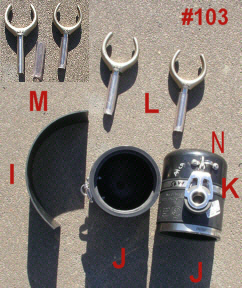
Photo #103 is a close-up of the oarlock mounting device and the oarlocks with their sleeves. The oarlock mounting device is made from the following parts:
* Shown as "J": One four inch length of four (4) inch ABS pipe
* Also shown as "J": One ABS/SDR coupler for four (4) inch pipe with two hose clamps
* Also shown as "J": One end cap for four (4) inch ABS pipe with hole drilled in center to accommodate an oarlock. (the hole is not necessary unless oar locks are part of your plan.
* Shown as "I": One shim made of 1/8 inch neoprene cut to fit internal diameter of the 4 inch ABS pipe section.
* Shown as "M": Sleeve made of 5/8 inch clear tubing, with bevelled end to facilitate a tight fit into the winch handle slot on the jibsheet winch. (not necessary unless oarlocks are part of your plan)
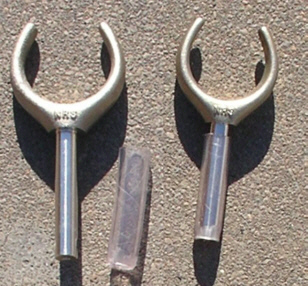
* Shown in the photo as "N": one pad eye and fasteners (bolt, two washers and lock nuts). The series 25 block will attach to the pad eye. The pad eye fasteners will hold the end cap onto the ABS pipe, and could also be used to secure the 1/8 inch thick neoprene shim "I".
* Shown as "K": One series 25 ball bearing block (also pictured elsewhere as block "G", however as "G" this block has an attached snap hook. As "K" it does not)
* Not shown here: A short Dacron line to tether the device to a pad eye or cleat. I used a piece of Dacron cord with a snap hook.This cord is attached to a pad eye used in my jack line system. The pad eye is located just forward of the jibsheet winch on the deck outboard of the coaming board"
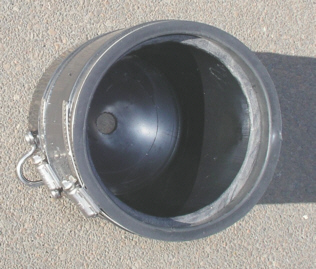
The photo to the left shows an internal view of the device "J". You can see the center hole in the end cap and the the four (4) inch ABS pipe within the coupler. The neoprene shim is not shown in this photo.
The photo to the right above shows the oar locks. The oarlock on the right is shown with the sleeve in place. The oarlock on the left is shown beside its sleeve. The ends of the sleeves are tapered to slide into the top of the winch.
The jibsheet winches on Ariel #330 are Barient #_. The diameter of the base is four (4) inches, but the diameter of the top of the winch is three and three-quarters (3 3/4) inches, hence the need to recess the ABS pipe in the coupler and also the need for the neoprene shim. If your winches are a different size, you will have to search for an alternative pipe size or a thicker shim. The ABS pipe begins just above the first (lowest) pipe clamp on the coupler. This allows the diameter of the bottom of the device to be increased or reduced slightly to fit tightly around the winch base.
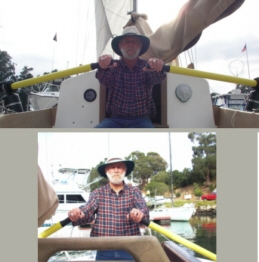
Adjustment of the lower hose clamp may be needed periodically, but is not necessary to adjust the clamp to install or remove the device from the winch.
Whether or not you are going to utilize this device as an oar lock for one sweep or two, you will want to build two of these devices, one for each jibsheet winch. And if you build two of these devices, you will have two tankards from which your crew of two can drink their daily ration of grog. A few rowing blisters and your crew will be screaming for grog.
The height of the oarlocks above the deck is a factor in the design related to your seated or standing position while rowing. The photo below, shows a rower demonstrating my new devices and the oar position at the dock both facing aft while sitting on the bridge deck (top image) and standing while facing forward (bottom image).
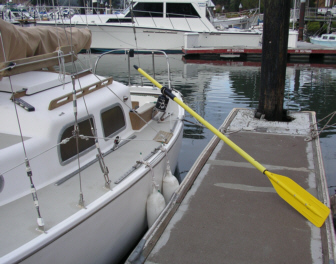
The photo to the left shows one of the NRS 11 foot sweeps at the dock to show the length of the oar in relation to the boat. The oars can be used individually or together.
I had an opportunity about three miles off shore to use my new NRS oars when I was becalmed at dusk for about a half hour before the north wind came up, and on another occasion when I was becalmed. The oars and oarlocks functioned well, although I must say that rowing an Ariel is a bit of work. Since this was a new installation in November 2005, I am still experimenting with the installation.
If you visit the Augustine self-steering page, you will see the other reason why I designed these oarlock mounting devices. The devices provide double duty as mounting devices for a block needed in the jibsheet-to-tiller self-steering gear. The block reduces friction while running the jibsheet transversely across the cockpit.
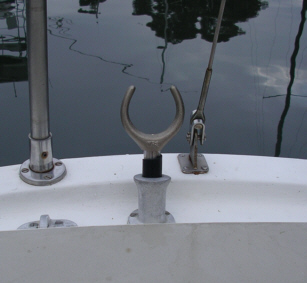
I also built a prototype of a holder for these same oarlocks that will fit in my flag pole holder on the transom. In preliminary tests at the dock and at sea. this third "sculling" oarlock seems to work. It is a very simple device, but I am not sure that the aluminum flag pole holder or its fasteners are up to the task.
If the flag pole holder were to be used for this purpose on a regular basis, a backing plate would be appropriate. Additional experiments will be conducted to determine the feasibility of using the flag pole holder as an oarlock mount for a sculling oar. Alternatively, a commercially available oarlock like that pictured in photo #03 below could be mounted on the port side of the backstay if it were mounted on a teak block and fastened through the deck and a below deck backing plate.
Alternatives Considered But Not Selected
Although all of the criteria in the Introduction section above were important, the chief reasons for designing the oarlock mounting device that I did was because:
1. I wanted this device to also be a secure base for attachment of a turning block for the jibsheet-to-tiller steering system, and
2. I wanted the oarlocks and mounts to be removable.
Several of the alternative devices pictured in this section would have met most or all of the remaining criteria.
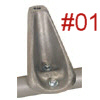
Since the NRS oar locks that I purchased with my Carlisle oars are designed for river rafting, the oar lock mounts available from NRS are designed to mount on steel frame rails. The oar lock mount in photo #01 is an NRS Oarlock.
NRS http://www.nrsweb.com makes this rail mount for their oarlocks, and sells them for $69.95 a pair. They mount to a rail using U bolts (sold separately). Although there is much to recommend in this mount for a river rafting application, it would be difficult to accommodate on a Pearson Ariel.
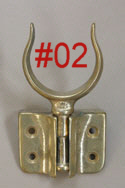
The high one inch thick coaming boards on the Pearson Ariel ruled out the installation of standard top mounted row boat style oar lock mounts. Photo #02 shows a very fine integral oarlock and mount manufactured by Davis. This oarlock has the additional advantage that it folds down out of the way when it is not in use.
The Davis Oar Lock in photo #02 is sold in pairs. A pair goes for $43.00. About it, the Shaw and Tenney website http://www.shawandtenney.com/marine-hardware.htm says “Used primarily on sailboats, these oarlocks lift up in the socket then swing down to hang out of the way inside the boat when not in use. They are available in a #1 size only. Made of Manganese Bronze."
Although it could be accommodated on the outside of the coaming boards, this oarlock and mount was not selected for this application because the jibsheet winches protrudes above the coaming boards and could interfere with the full motion of the oars if the oarlocks were mounted in the vicinity of the winches. Additionally it is difficult to assess how much stress these locks might transfer to the relatively unsupported top of the coaming boards.
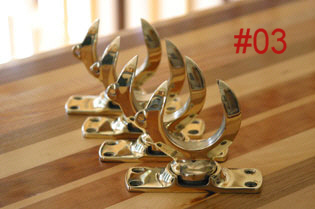
Similarly the oarlock and mount featured in photo #03 could not be installed near the winch without potential interference, and would require a modification of the coaming board to support the mount. Photo #03 is a more expensive Patent Swivel Oar Lock about which Shaw an Tenney says, “Extensively used prior to WWII, these rowlocks are still seen today on many antique boats and canoes. The customer demand for these reproductions has prompted us to make them once again. They are supplied in polished (shown) or burnished Manganese Bronze.”…for price of $159 per pair.
This would be an easy mount on a small wooden block or directly on the deck at the stern for sculling. In that event, the oarlock should be mounted on a raised block and through bolted to the port side of the backstay opposite the flag pole holder.
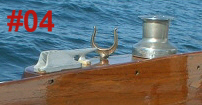
To keep your head spinning with the possibilities, here are a couple of photos of oar lock applications that might work on Ariel or Commander coaming boards. I cannot speak to the issue of whether the stress would be excessive on the boards in the device shown in photo #05a and #05b. I guess it would depend on the oar length and sea conditions.The approaches shown in photos #04 and #05 a and b have been taken on sailboats with high wood coaming boards. In photo #04 a wood box adjacent to the coaming board accommodates the winch, a cleat and an oarlock.
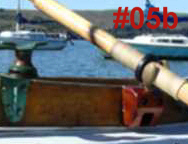
In photo #05a and #05B, a well thought out home designed and built oar mount was built of wood and attached to the coaming boards. These well designed successful applications represent sound approaches, but require permanent modifications to the boat.
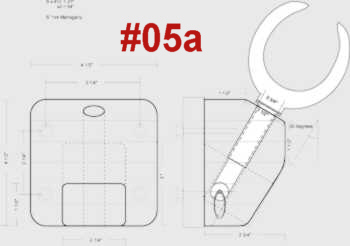
Since jib sheet winch mounts are through-bolted through Augustine's deck and also through the coaming boards, an oar mount that would attach to the winch base or winch was determined to be the best alternative. Also, the jibsheet winch is positioned well for installation of an oarlock both longitudinally and in height. Since rowing is reserved for emergency conditions, a removable mount and oar lock was determined to be the best option.
Edey and Duff makes a The Edey and Duff winch top bronze oar locks are $55 each. Edey and Duff report that their oarlocks will fit any winch.
Others may wish to pursue the Edey and Duff alternative, or build permanent oar mounting boxes from wood.
By the time that I obtained a quote from Edey and Duff, I had already built the oar mounts for Augustine. Since the devices that I built as portrayed on this page also function as integral parts of my jibsheet-to-tiller gear, and they are completely removable, they best meet my criteria.
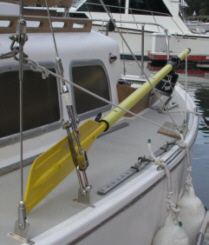
The oars may be lashed on the cabin top, or in calm water, if you are otherwise not using the jibsheet winches, they may be left in the oar locks and temporarily stored longitudinally in one of two positions shown on this page. For longer term storage, the oars may be separated into two sections and stored beneath the cockpit.
To facilitate easy access and trouble free storage, a three (3) foot length of light weight six inch diameter perforated drain pipe was secured to the port side panel that separates the starboard cockpit locker from the area beneath the cockpit floor. This places the six inch pipe beside the tiller post and hard against the aft bulkhead that separates the lazarette locker from the rest of the boat. I used perforated pipe to better facilitate drainage and ventilation.
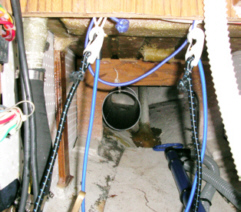
The space beneath the cockpit is accessed by removing the companionway steps. Although awkward to accomplish under sail, the steps can be quickly removed to allow the oars to be accessed.
Shown in the second photo in this section is the top section of one oar in its stowed position. The multiple blue bungee cords were later replaced with a simple permanent strap which supports the forward end of the oars. The single blue-flecked black bungee cord shown in the second and third photos is used to secure the stowed oars. I leave the paddles in place on the lower oar section during storage.
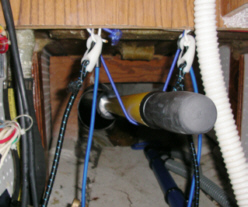
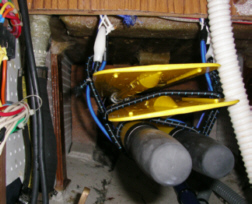
The third photo in his section shows the four oar sections with paddles installed stowed beneath the cockpit behind the companionway steps.
Copyright by Scott Galloway ©. 2005. All rights are reserved.

Return to Solo Publications Web Index
Back To The Table of Contents